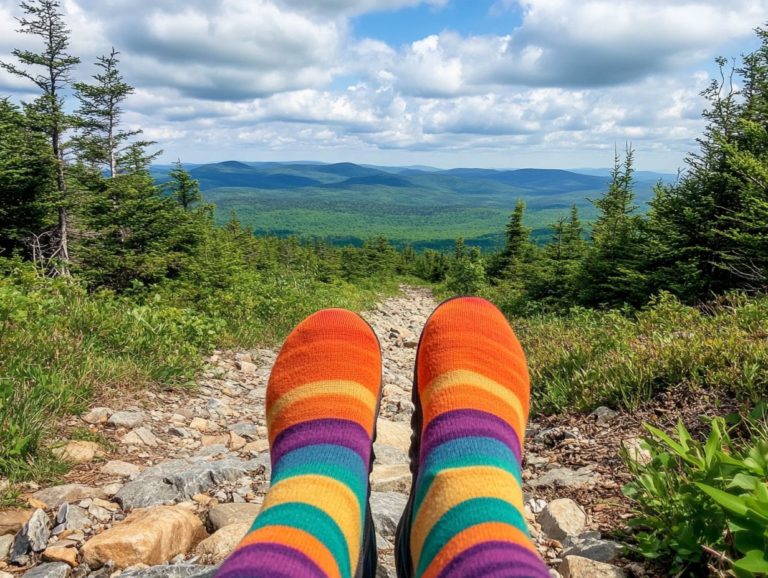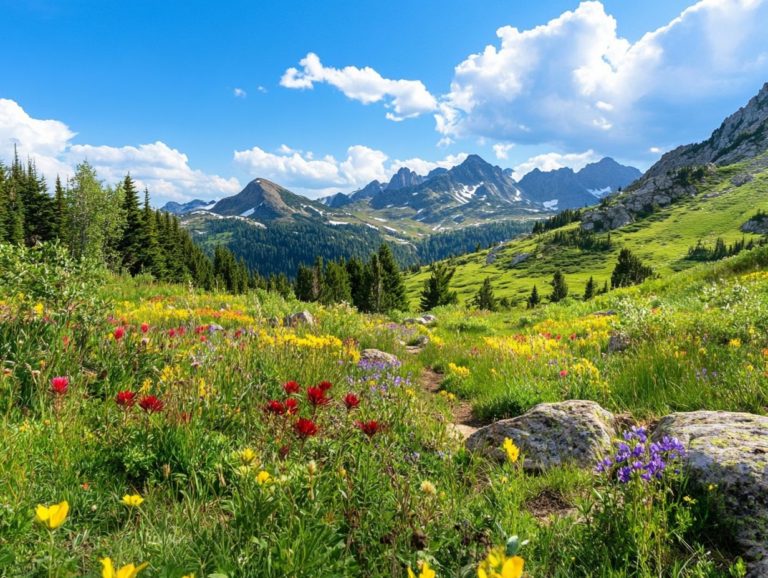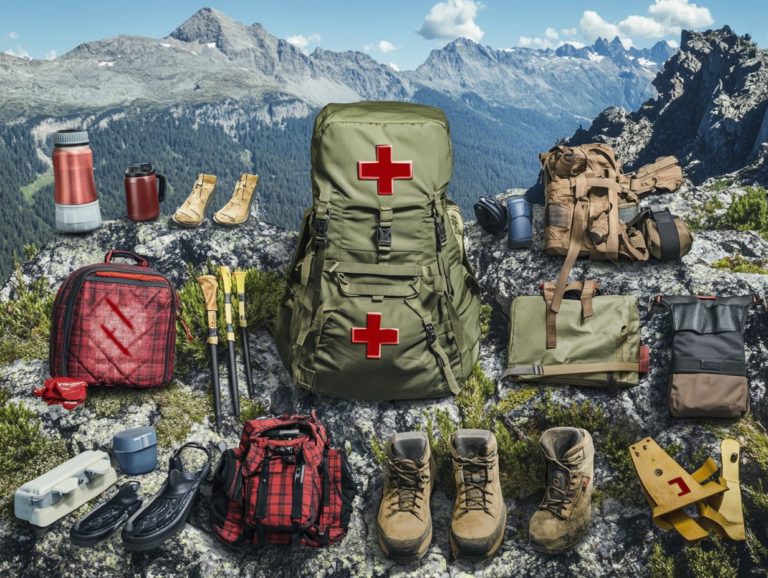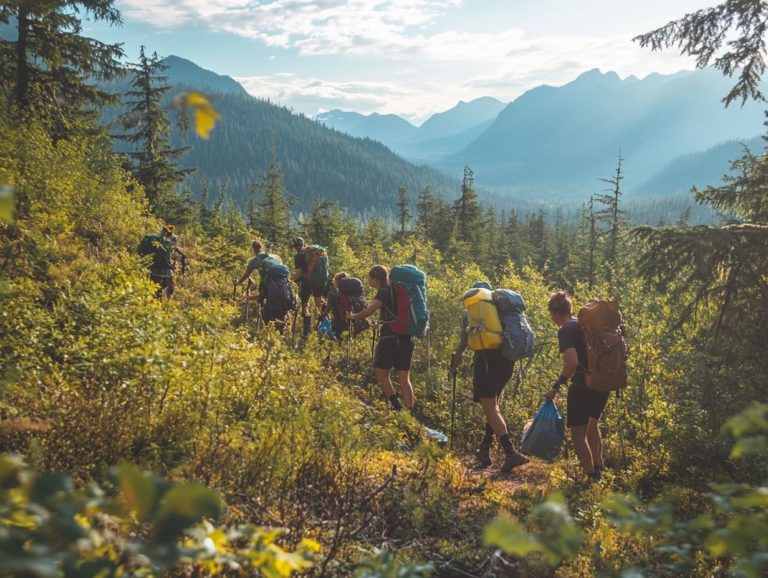How to Stay Warm While Hiking
As the temperatures drop, you ll find the allure of winter hiking calling you to explore breathtaking landscapes transformed by frost and snow.
Navigating those chilly trails requires careful preparation to ensure both your safety and comfort. This guide will walk you through essential gear and clothing, along with effective techniques for layering and insulation so you can tackle the cold with confidence.
You ll also find tips for staying active to maintain warmth and how to handle unexpected cold weather scenarios. Staying hydrated and nourished on the trail is crucial.
Get ready to dive into the thrill of winter hiking and savor the beauty that winter hikes have to offer!
Contents
- Preparing for Cold Weather Hiking
- Techniques for Staying Warm
- Dealing with Unexpected Cold Weather
- Staying Hydrated and Nourished
- Frequently Asked Questions
- How can I stay warm while hiking?
- What should I wear to stay warm while hiking?
- What type of material should I choose for my layers?
- Do I need to wear a hat while hiking to stay warm?
- Should I bring extra layers while hiking in winter?
- Are there specific types of socks I should wear to prevent cold exposure?
- Are there other items I should bring to stay warm while hiking in winter conditions?
Key Takeaways:
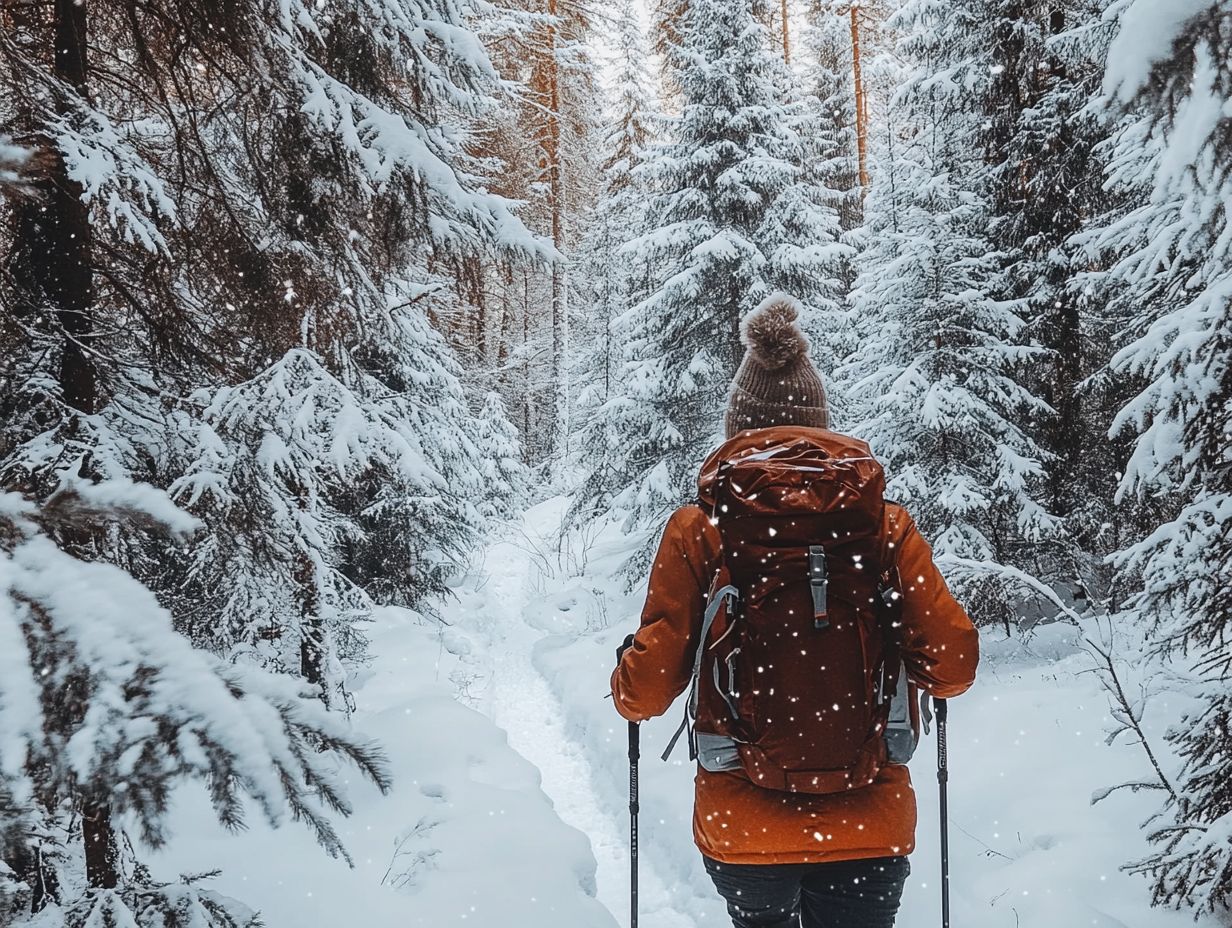
- Always pack essential gear and clothing for cold weather hikes to stay warm and safe.
- Properly layer and insulate to trap heat and protect yourself from the cold while hiking.
- Stay hydrated and nourished by drinking plenty of water and eating regular snacks to maintain body warmth while hiking in cold weather.
Preparing for Cold Weather Hiking
Preparing for cold weather hiking requires a solid understanding of winter conditions. Selecting the right gear ensures your safety and comfort.
The distinct challenges of winter hiking, particularly on legendary trails like Mt. Hood, necessitate proper clothing layers to help you manage your body temperature effectively.
You ll want to start with a fabric that pulls sweat away from your skin, add insulating layers, and top it off with waterproof outer shells; each piece is vital in crafting a dependable layering system.
Don t forget to include essential winter hiking gear such as trekking poles and microspikes on your checklist. They ll be invaluable in navigating diverse snow conditions and making your outdoor adventure a resounding success.
Essential Gear and Clothing
The right gear and clothing are crucial for enjoying winter hiking, as they significantly impact your comfort and safety on the trails.
A well-thought-out winter hiking outfit consists of a moisture-wicking base layer, an insulating mid layer, and a waterproof outer layer to shield you from the elements.
Start with the base layer, made from breathable fabrics like merino wool or advanced synthetics, which effectively wick moisture away from your skin. This keeps you dry and helps prevent the chill that damp clothes can bring.
Next is the mid layer, your insulating hero. Opt for materials like down or fleece, ideally from reputable brands that strike the perfect balance between warmth and compressibility for easy packing.
To top it off, a reliable waterproof outer layer is essential. Gear featuring GoreTex technology keeps water at bay while allowing sweat vapor to escape, reducing the risk of hypothermia.
By thoughtfully combining these layers, you can ensure maximum comfort and safety while navigating the stunning yet rugged beauty of winter landscapes.
Techniques for Staying Warm
Techniques for staying warm during winter hiking are essential for your comfort and safety, particularly in challenging conditions.
By adopting proper layering techniques, you can greatly improve your ability to regulate body temperature and fend off the winter blues, ensuring that your hiking experience remains enjoyable and fulfilling.
Start your winter hiking adventure today!
Proper Layering and Insulation
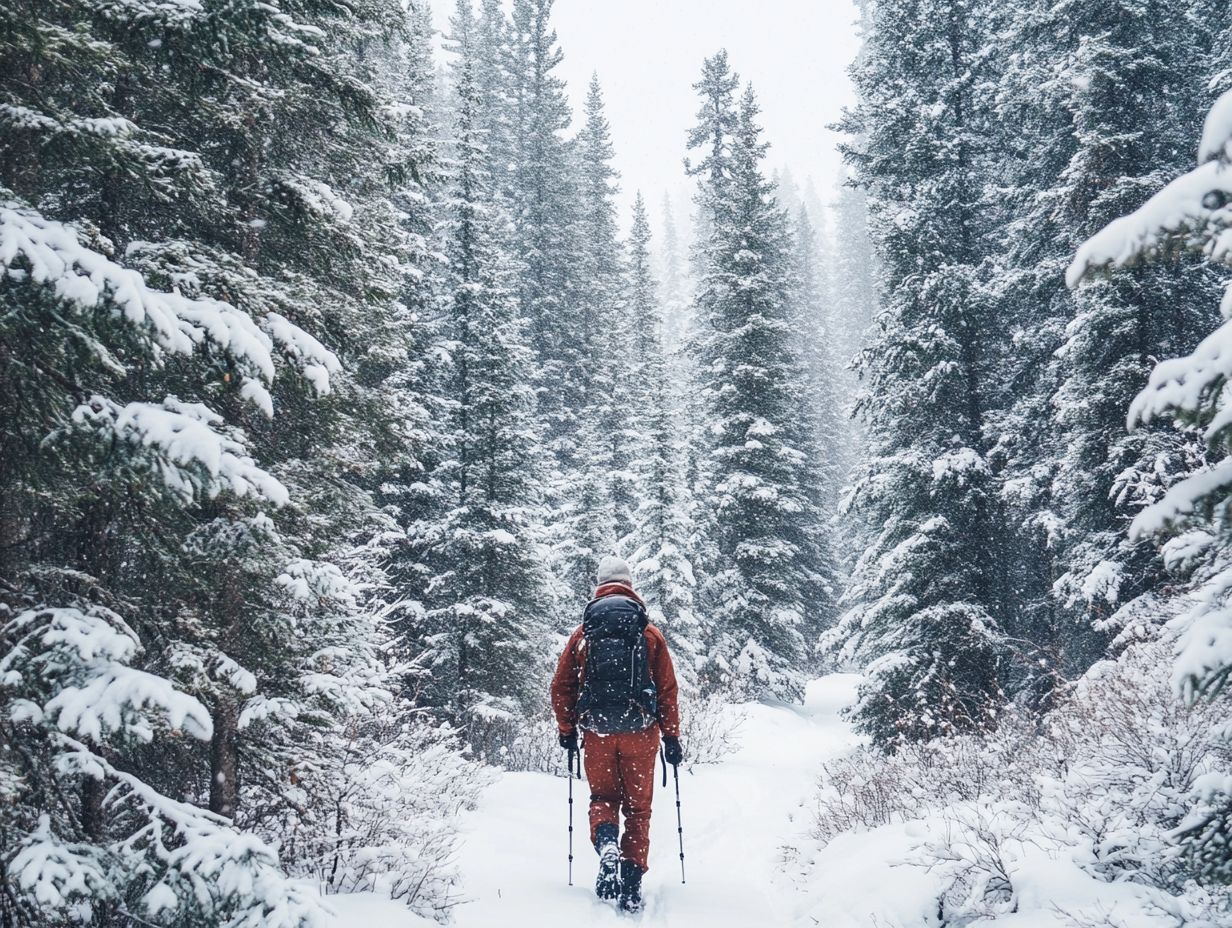
Proper layering and insulation are essential for keeping you warm and comfortable during winter hikes, especially on those challenging trails.
A moisture-wicking base layer is your best friend for drawing sweat away. An insulating mid-layer keeps your body heat in, while an outer layer protects against wind and moisture.
Each layer has its own role, providing the flexibility to adapt to changing temperatures and conditions. Your base layer, often made from synthetic materials or merino wool, keeps your skin dry and helps regulate your body temperature.
The mid-layer, typically made of fleece or down, offers warmth without adding bulk perfect for those active pursuits.
Then there’s the outer layer, usually made from waterproof or water-resistant fabrics like Gore-Tex. This layer shields you from harsh elements while remaining breathable.
Brands like Patagonia and The North Face have exceptional options for each layer, ensuring you get the insulation and protection you need.
Understanding how these layers interact is crucial for any outdoor enthusiast who wants to stay comfortable and safe on their adventures.
Movement and Activity Tips
Movement and activity tips are vital for ensuring a safe and enjoyable winter hiking experience. They directly influence your body temperature and overall performance.
Understanding how to manage your pace and activity level can help you avoid the risks of overheating or excessive exposure to the cold.
When you venture into the winter wilderness, it s crucial to maintain a steady, manageable pace that allows your body to adapt to temperature shifts. Recognizing the signs of hypothermia like uncontrollable shivering, confusion, or fatigue can significantly enhance your safety.
Scheduling regular breaks to hydrate and refuel will keep your energy levels high and morale boosted. Incorporating alpine starts into your routine maximizes daylight hours and helps you sidestep sudden weather changes, resulting in a more secure and enjoyable hiking experience.
This strategic approach promotes both safety and efficiency as you navigate the frosty terrain.
Dealing with Unexpected Cold Weather
Navigating unexpected cold weather while hiking demands both thorough preparation and an understanding of emergency protocols. This knowledge safeguards your safety and well-being.
Given that winter conditions can shift with little warning, having a well-thought-out plan can significantly reduce the risk of serious issues such as hypothermia or snow blindness.
Emergency Measures and Strategies
Implementing effective emergency measures and strategies can truly be the line between safety and danger when you re hiking in cold weather. Carrying a well-equipped first aid kit is essential, enabling you to respond swiftly to any medical concerns that may arise.
Your kit should include vital items such as:
- Adhesive bandages
- Antiseptic wipes
- Gauze
- Thermal blankets
These essentials are your first line of defense against injuries and can help stave off hypothermia. Stay vigilant for signs of cold exposure like shivering, confusion, and extreme fatigue. If you notice these symptoms, find shelter from the wind, ditch any wet clothing, and layer yourself with dry, insulating materials.
Hot beverages can work wonders in warming you up, but avoid alcohol; it’ll only make you lose heat faster. By effectively using the contents of your first aid kit and recognizing the symptoms of cold exposure, you can ensure a safer journey on those frosty trails. Additionally, having the right winter hiking gear essentials can make all the difference.
Staying Hydrated and Nourished
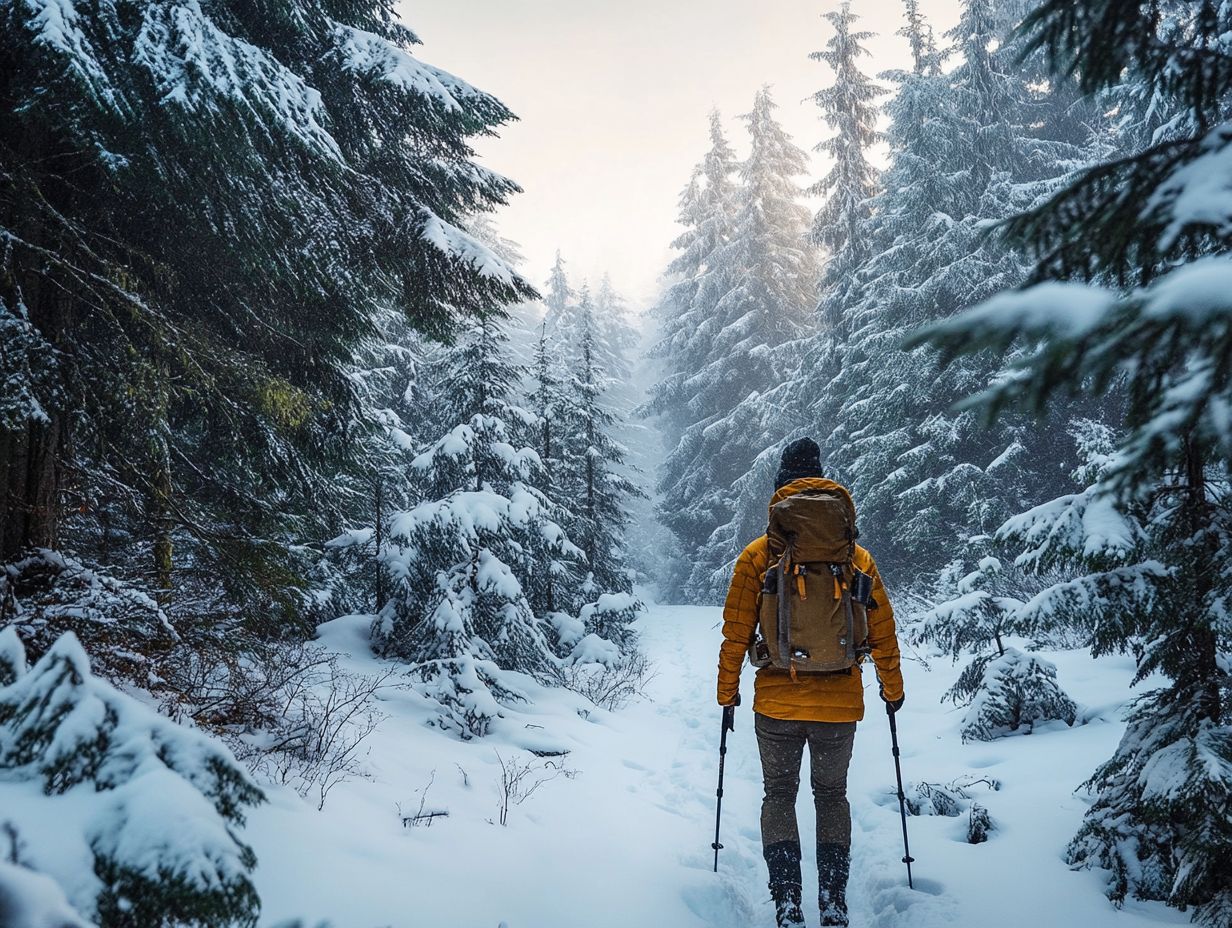
Staying hydrated and nourished is essential for maintaining your energy levels during winter hikes. The cold can easily disguise your thirst.
Proper hydration and nutrition not only elevate your hiking experience but also play a critical role in preventing fatigue and enhancing your overall safety on the trails.
Gear up now and enjoy the beauty of winter hiking safely!
Importance of Water and Food Intake
The significance of water and food intake during winter hiking cannot be overstated. They are essential for maintaining your energy levels and overall performance.
Proper hydration is crucial. Nutritious snacks help sustain your energy during the hike.
In chilly weather, it’s important to select hydrating beverages that quench your thirst and help you retain warmth. Consider indulging in hot drinks like herbal tea, warm broth, or even hot chocolate. Each offers hydration and a comforting embrace.
As a winter hiker, think about packing energy-dense foods, which are foods that provide a lot of energy in a small volume. Some great options include:
- Nuts
- Energy bars
- Dried fruits
These snacks not only fuel your body but also help keep you warm on those chilly trails. By adopting a thoughtful approach to hydration and nutrition, you’ll find that your journey can be more enjoyable and safer.
Frequently Asked Questions
How can I stay warm while hiking?
Staying warm while hiking is essential for a comfortable and enjoyable experience. Here are some tips to help you:
What should I wear to stay warm while hiking?
Layering is key. Wear a base layer, a mid-layer, and an outer layer to trap heat and keep you warm.
What type of material should I choose for my layers?
Choose materials that are moisture-wicking and quick-drying, such as wool or synthetic fabrics like polyester. Avoid cotton, as it absorbs moisture and can make you feel cold.
Do I need to wear a hat while hiking to stay warm?
Yes, wearing a hat is important because a significant amount of heat is lost through your head. Choose a hat that covers your ears to keep them warm.
Should I bring extra layers while hiking in winter?
It’s always a good idea to bring extra layers, especially in colder temperatures. You can remove layers if you get too warm, but it’s better to have them just in case.
Are there specific types of socks I should wear to prevent cold exposure?
Wearing moisture-wicking socks is essential for staying warm. They keep your feet dry and prevent blisters. You can also wear a thin liner sock underneath for added warmth.
Are there other items I should bring to stay warm while hiking in winter conditions?
Bringing hand and foot warmers, along with a small emergency blanket, can be helpful in colder temperatures. Also, make sure to pack snacks and plenty of water to keep your energy levels up and your body warm.
Get ready for your adventure! Stay warm and enjoy every moment on the trail!


